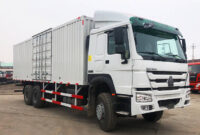Looking For Pickup Trucks For Sale: Your Comprehensive Guide to Finding the Perfect Ride pickup.truckstrend.com
The search for a pickup truck is more than just a casual browse; it’s an exciting journey into a world of versatility, power, and utility. Whether you’re a seasoned contractor needing a reliable workhorse, an outdoor enthusiast seeking adventure, a family looking for a spacious and capable vehicle, or simply someone who appreciates the sheer utility a truck offers, finding the right pickup truck for sale requires careful consideration, research, and a clear understanding of your needs.
This comprehensive guide is designed to empower you with the knowledge and insights needed to navigate the complex landscape of the pickup truck market. We’ll delve into everything from defining your specific requirements and budget to understanding the nuances of new versus used vehicles, where to find them, how to inspect them, and the crucial steps of financing and negotiation. By the end, you’ll be well-equipped to make an informed decision and drive away with the pickup truck that perfectly fits your lifestyle and demands.
Looking For Pickup Trucks For Sale: Your Comprehensive Guide to Finding the Perfect Ride
Section 1: Defining Your Needs and Budget – The Foundation of Your Search
Before you even start browsing listings, the most critical first step is to clearly define what you need and what you can afford. This foundational planning will streamline your search and prevent you from being overwhelmed by the sheer number of options available.
1.1 Purpose and Usage: What Will Your Truck Do?
- Workhorse: Will you be hauling heavy equipment, towing large trailers, or carrying significant payloads? This dictates payload capacity, towing capability, and often, the need for a heavy-duty (HD) model.
- Daily Driver/Commuter: Is it primarily for getting around town, with occasional hauling? Fuel efficiency, ride comfort, and technology features might be higher priorities.
- Recreation/Off-Roading: Do you plan to hit trails, go camping, or transport ATVs/boats? Look for 4×4 capability, higher ground clearance, and specialized off-road packages.
- Family Vehicle: Do you need space for passengers, car seats, and cargo? Crew cab configurations become essential.

1.2 Key Specifications and Features
- Payload & Towing Capacity: Don’t guess. If you know you’ll be towing a specific boat or trailer, find its weight and add a buffer. Payload refers to the weight the truck can carry in its bed and cab. This is often the most overlooked specification.
- Cab Style:

- Regular Cab: Two doors, one row of seating. Best for maximizing bed length and lowest cost.
- Extended Cab (Access Cab/Quad Cab): Two full-size front doors and two smaller rear doors (often suicide doors). Offers a small rear seating area, suitable for occasional passengers or extra storage.
- Crew Cab (Double Cab/SuperCrew): Four full-size doors and a spacious rear seating area, similar to an SUV. Ideal for families or transporting multiple adults comfortably.
- Bed Length:
- Short Bed: Typically 5-5.5 feet. Common on crew cabs for easier maneuverability.
- Standard Bed: Around 6.5 feet. A good balance of capacity and manageability.
- Long Bed: 8 feet or more. Max payload and towing, often on regular or extended cabs, less maneuverable.
- Drivetrain:
- 2WD (Two-Wheel Drive): Typically rear-wheel drive (RWD). More fuel-efficient, less expensive, fine for paved roads and light hauling.
- 4WD (Four-Wheel Drive): Essential for off-roading, snow, mud, or slippery conditions. Can be part-time (for off-road only) or full-time (can be used on pavement).
- AWD (All-Wheel Drive): Less common in traditional pickups but found in some (e.g., Honda Ridgeline). Provides continuous power to all wheels for enhanced traction on various surfaces.
- Fuel Type:
- Gasoline: Most common, generally lower upfront cost, widely available fueling.
- Diesel: Higher torque for heavy towing, better fuel economy (especially when loaded), longer engine life, but higher upfront cost and maintenance.
- Hybrid/Electric: Emerging options like the Ford F-150 PowerBoost and upcoming Chevy Silverado EV/Ford F-150 Lightning offer impressive fuel economy and unique power export capabilities, but with higher price tags.

1.3 Setting Your Budget
Your budget should encompass more than just the sticker price.
- Purchase Price: New trucks range from $30,000 to over $80,000. Used trucks can be found for under $10,000 to over $50,000 depending on age, mileage, and condition.
- Insurance: Trucks often have higher insurance premiums due to their size, repair costs, and potential for damage. Get quotes before buying.
- Fuel Costs: Consider the truck’s estimated MPG and your typical driving habits.
- Maintenance: Diesels generally have higher maintenance costs. Older trucks will likely require more frequent repairs.
- Registration and Taxes: Factor in local fees and sales tax.
Section 2: New vs. Used – Making the Right Choice
This is one of the biggest decisions in your truck-buying journey, each with its own set of advantages and disadvantages.
2.1 New Trucks
Pros:
- Warranty: Full factory warranty offers peace of mind against unexpected repairs.
- Latest Technology: Access to the newest safety features, infotainment systems, and engine technologies.
- Customization: You can order exactly the trim, features, and color you want.
- No Prior History: You’re the first owner, so no worries about previous accidents or neglect.
- New Car Smell: It’s a real thing!
Cons:
- Depreciation: New trucks lose a significant portion of their value the moment they leave the lot.
- Higher Cost: Generally more expensive than comparable used models.
- Higher Insurance: Typically more costly to insure.
2.2 Used Trucks
Pros:
- Lower Price: Significant savings compared to a new truck, especially for models a few years old.
- Less Depreciation: The steepest depreciation has already occurred, meaning your truck holds its value better.
- Wider Selection: Access to models that might be out of production or specific trims no longer offered new.
- Proven Reliability: You can research common issues for specific model years.
Cons:
- Unknown History: Unless you get a thorough history report and inspection, you might not know how the truck was treated.
- Potential for Repairs: Older trucks may require more maintenance or have existing issues.
- Fewer Features: May lack the latest technology or safety features.
- No Warranty (or Limited): Most private sales are "as-is." Dealerships might offer limited warranties.
2.3 Certified Pre-Owned (CPO) Trucks
CPO vehicles are a hybrid of new and used. These are used trucks (usually less than 5-6 years old and under 100,000 miles) that have undergone a rigorous multi-point inspection by the manufacturer and come with an extended factory warranty.
Pros:
- Manufacturer-Backed Warranty: Offers much greater peace of mind than a standard used car warranty.
- Thorough Inspection: Vehicles are typically reconditioned to a high standard.
- Additional Perks: Often include roadside assistance, loaner vehicles, or satellite radio subscriptions.
Cons:
- Higher Price: More expensive than a non-CPO used truck.
- Limited Selection: Only available at franchised dealerships for that specific brand.
Section 3: Where to Look – Navigating the Market
Once you know what you’re looking for, it’s time to explore where to find it.
3.1 Dealerships (New & Used)
- Franchised Dealerships (New & Used): Offer new trucks of a specific brand, plus a wide selection of used vehicles, including CPO options.
- Pros: Large inventory, financing options, trade-in capabilities, service departments, professional sales staff.
- Cons: Prices can be higher, potential for sales pressure, added fees.
- Independent Used Car Dealerships: Specialize in selling pre-owned vehicles of various makes and models.
- Pros: Potentially lower prices, wider variety of brands, less brand-specific pressure.
- Cons: Inventory varies greatly in quality, financing terms might be less favorable, limited or no warranty.
3.2 Online Marketplaces
These platforms are invaluable for research and finding vehicles.
- Major Aggregators: Autotrader, CarGurus, Edmunds, Cars.com.
- Pros: Vast selection from dealerships and private sellers, powerful search filters (price, mileage, features, location), comparison tools, vehicle history report links.
- Cons: Can be overwhelming, need to verify seller credibility.
- Brand-Specific Sites: Manufacturers’ websites (e.g., Ford.com, RamTrucks.com) often have "locate inventory" tools.
3.3 Private Sellers
Websites like Craigslist, Facebook Marketplace, local classifieds, and "for sale" signs.
- Pros: Potentially the lowest prices, direct negotiation with the owner, often more flexible meeting times.
- Cons: "As-is" sales (no warranty), higher risk of scams, need to arrange financing yourself, responsibility for all paperwork, harder to assess trustworthiness.
3.4 Auctions
Government auctions, impound lots, salvage auctions.
- Pros: Extremely low prices.
- Cons: High risk, often damaged vehicles, limited or no opportunity for inspection, typically requires cash payment, often for dealers only. Not recommended for first-time buyers.
Section 4: The Inspection Process – Don’t Skip This Step!
This is where you protect yourself, especially when buying used.
4.1 Visual Inspection (Exterior and Interior)
- Exterior:
- Check for rust, especially on the frame, wheel wells, and underbody.
- Look for uneven panel gaps, mismatched paint, or wavy body panels – signs of prior accidents/repairs.
- Inspect tires for even wear and tread depth. Check the spare.
- Test all lights, signals, and wipers.
- Interior:
- Check for excessive wear on seats, steering wheel, and pedals (could indicate higher mileage than odometer).
- Test all electronics: infotainment, power windows, locks, mirrors, climate control, charging ports.
- Look for water stains, mold, or persistent odors (smoke, mildew) that could indicate leaks or neglect.
- Under the Hood:
- Look for fluid leaks (oil, coolant, transmission fluid).
- Check fluid levels and color (e.g., clear, not murky, transmission fluid should be red).
- Inspect belts and hoses for cracks or wear.
- Check the battery terminals for corrosion.
4.2 The Test Drive
This is your chance to feel how the truck performs.
- Drive at various speeds, including highway speeds.
- Listen for unusual noises: squeaks, rattles, clunks, grinding, whining.
- Test the brakes: smooth, no pulling, no excessive pedal travel.
- Check steering: responsive, no excessive play, no pulling to one side.
- Observe transmission shifts: smooth, no jerking or slipping.
- Test the heating and air conditioning.
- Try parking it to assess maneuverability.
4.3 Vehicle History Report (VHR)
Services like CarFax or AutoCheck are indispensable for used trucks. They provide:
- Accident History: Reported accidents, structural damage.
- Service Records: Maintenance history, odometer readings.
- Ownership History: Number of owners, type of use (personal, commercial, rental).
- Lien/Salvage Status: Important to ensure a clear title.
- Recalls: Unresolved safety recalls.
4.4 Pre-Purchase Inspection (PPI)
For any used truck you are serious about, a PPI by an independent, trusted mechanic is highly recommended.
- They will put the truck on a lift, check the frame, suspension, exhaust, and powertrain for issues you might miss.
- They can identify potential costly repairs, giving you leverage for negotiation or a reason to walk away.
- Consider it a small investment that can save you thousands.
Section 5: Financing, Negotiation, and Paperwork
You’ve found the truck; now it’s time to seal the deal.
5.1 Financing Options
- Get Pre-Approved: Before stepping into a dealership, get pre-approved for a loan from your bank or credit union. This gives you a clear budget and negotiation power.
- Dealership Financing: Dealerships work with various lenders and may offer competitive rates, but compare them to your pre-approval.
- Cash: If you can pay cash, you simplify the process and avoid interest, but ensure you don’t deplete your emergency fund.
5.2 Negotiation Strategies
- Research Market Value: Know the fair market price for the specific truck (using sites like Kelley Blue Book, Edmunds, NADAguides).
- Focus on the "Out-the-Door" Price: Don’t just negotiate the monthly payment. Focus on the total price including all fees, taxes, and add-ons.
- Be Prepared to Walk Away: This is your strongest negotiating tool. There are always other trucks.
- Trade-Ins: Negotiate the truck price first, then discuss your trade-in as a separate transaction.
- Don’t Rush: Take your time, ask questions, and don’t feel pressured.
5.3 Paperwork
- Read Everything Carefully: Before signing anything, read all documents thoroughly.
- Bill of Sale: Ensures the transfer of ownership and outlines the purchase price.
- Crucial document proving ownership. Ensure it’s clear of liens.
- Loan Documents: Understand your interest rate, loan term, and total amount repayable.
- Warranty Information: If applicable, understand what is covered and for how long.
- Registration: Know what’s required for registering the truck in your state.
Section 6: Popular Pickup Truck Models & Considerations
While personal preference and specific needs dictate the best choice, here’s a brief overview of popular categories:
- Full-Size Trucks (e.g., Ford F-150, Chevy Silverado 1500, Ram 1500, Toyota Tundra, Nissan Titan): These are the most common, offering a balance of capability, comfort, and technology. The F-150 and Silverado are perennial best-sellers, known for their wide range of trims and engine options. Ram is celebrated for its interior luxury and coil-spring suspension comfort. Tundra is known for its legendary reliability.
- Mid-Size Trucks (e.g., Toyota Tacoma, Chevy Colorado/GMC Canyon, Ford Ranger, Honda Ridgeline, Nissan Frontier): More maneuverable, better fuel economy than full-size, and still capable for many tasks. The Tacoma is a go-to for off-roading and resale value. The Ridgeline offers car-like comfort and unique storage.
- Heavy-Duty (HD) Trucks (e.g., Ford F-250/350, Chevy Silverado/GMC Sierra 2500/3500, Ram 2500/3500): Built for serious towing and hauling (e.g., large RVs, commercial trailers). These typically offer powerful diesel engine options and robust chassis. Only consider an HD if your towing/payload needs genuinely exceed a half-ton truck’s capacity, as they are more expensive to buy, fuel, and maintain.
Table: Estimated Price Ranges for Pickup Trucks (Illustrative)
Please note: These are estimated price ranges and can vary significantly based on model year, trim level, mileage, condition, features, geographic location, and market demand. Always do your own research for specific vehicles.
| Truck Category | Estimated Price Range (USD) | Key Factors Influencing Price |
|---|---|---|
| New Full-Size | $35,000 – $80,000+ | Trim level (XL to Platinum/Limited), Engine (V6, V8, Hybrid), 2WD/4WD, Bed/Cab Configuration, Packages, Luxury features |
| New Mid-Size | $30,000 – $55,000+ | Trim level, Engine, 2WD/4WD, Off-road packages, Tech features |
| Used Full-Size | $15,000 – $50,000+ | Model Year (older = cheaper), Mileage, Condition, Trim, Engine, Accidents, Maintenance history, Location |
| Used Mid-Size | $10,000 – $35,000+ | Model Year, Mileage, Condition, Off-road capability, Brand (Tacoma often holds value better) |
| CPO Full-Size | $30,000 – $65,000+ | Model Year (usually 1-5 years old), Mileage (under 100k), Trim, Warranty length, Reconditioning costs |
| CPO Mid-Size | $25,000 – $45,000+ | Model Year, Mileage, Trim, Warranty length, Brand reputation |
| Older/High Mileage | $5,000 – $15,000 | Condition, Specific model’s known reliability, Rust, Mechanical issues, Maintenance records |
Frequently Asked Questions (FAQ)
Q1: How much should I budget for a used pickup truck?
A1: A reasonable budget for a reliable used pickup truck is typically between $15,000 and $30,000 for a solid, well-maintained model that’s a few years old. However, you can find options below $10,000 (often older or higher mileage) or well above $30,000 for newer, lower-mileage used trucks. Remember to include insurance, fuel, and potential maintenance costs in your overall budget.
Q2: What’s the difference between 2WD and 4WD, and which do I need?
A2: 2WD (Two-Wheel Drive) trucks power only two wheels (usually the rear wheels), offering better fuel economy and lower cost. They’re suitable for paved roads and light hauling. 4WD (Four-Wheel Drive) trucks can send power to all four wheels, providing superior traction in off-road conditions, snow, mud, or steep inclines. You need 4WD if you regularly encounter challenging terrain or adverse weather.
Q3: Is a diesel truck worth it?
A3: Diesel trucks offer superior towing capacity and fuel efficiency (especially when loaded), and often have longer engine lifespans. However, they come with a higher upfront cost, higher maintenance expenses, and more expensive diesel fuel. A diesel is generally only "worth it" if you frequently tow heavy loads or drive long distances, making the fuel economy and durability benefits outweigh the added costs.
Q4: How important is a vehicle history report?
A4: Extremely important! A vehicle history report (like CarFax or AutoCheck) can reveal crucial information such as accident history, previous ownership, service records, odometer discrepancies, and whether the vehicle has a salvage or flood title. It’s a vital tool to avoid buying a truck with hidden problems.
Q5: Can I negotiate the price of a new truck?
A5: Yes, absolutely. While the sticker price is often presented as fixed, most new truck prices are negotiable, especially the Manufacturer’s Suggested Retail Price (MSRP). Research the invoice price (what the dealer paid) and be prepared to negotiate based on market value, current incentives, and your pre-approved financing.
Q6: What’s the best time of year to buy a truck?
A6: Generally, the best times are:
- End of the Month/Quarter: Salespeople are trying to meet quotas.
- End of the Year (November/December): Dealerships want to clear out current year models for the new year’s inventory.
- When New Models Arrive: When new model years hit the lots (often late summer/early fall), dealers offer discounts on the outgoing model year.
Q7: Should I buy a truck with high mileage?
A7: "High mileage" is relative. For a well-maintained truck, 100,000-150,000 miles isn’t necessarily a deal-breaker, especially for reliable brands like Toyota or Ford. The key is maintenance records, a clean vehicle history report, and a pre-purchase inspection by a trusted mechanic. A high-mileage truck with documented maintenance is often a better buy than a lower-mileage truck with an unknown history.
Conclusion
Looking for pickup trucks for sale can feel like a monumental task, but by approaching it with a structured plan, you can transform it into an exciting and successful endeavor. Begin by meticulously defining your needs and a realistic budget, understanding that the right truck is the one that perfectly balances capability with affordability. Carefully weigh the pros and cons of new versus used vehicles, and leverage the vast resources of online marketplaces and reputable dealerships.
Crucially, never underestimate the power of a thorough inspection and a pre-purchase check by an independent mechanic. Armed with knowledge and patience, you’ll be able to confidently navigate the negotiation process and complete the necessary paperwork. With the right preparation, you’re not just buying a vehicle; you’re investing in a tool that will serve you faithfully for years to come, whether for work, adventure, or everyday life. Happy hunting, and may you find the perfect pickup truck that’s ready to tackle whatever comes your way!



